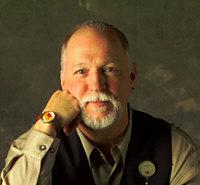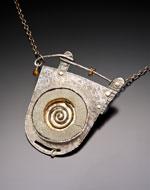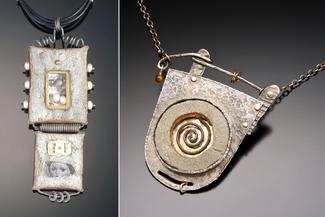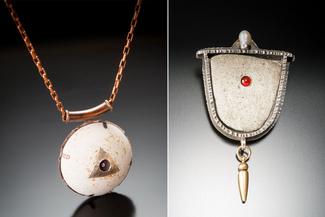Concrete: Not Just for Sidewalks Anymore
As unlikely as concrete for jewelry may seem, it is easy to use, extremely versatile, unbelievably inexpensive and…surprisingly lightweight. In fact it is lighter in weight then stone, resin or metal of comparable size. This makes it perfect for jewelry and other forms of personal adornment as well as small sculpture and utilitarian objects. It can even be pigmented in numerous ways and the surface can be finished with a variety of textures from very rough to smooth to polished!
Students will be able to “set” virtually any object in the concrete without the need for a bezel or finding – however those will be used in the concrete as well. Materials such as found objects, metal, glass, Ephemera, gemstones, bone and enamels can be “trapped in the concrete with no fasteners or mechanical means. And this is the perfect opportunity to use all of those bit and pieces that you like so much but can’t figure out how to incorporate into your work.
The concrete used in class is extremely strong even when made as thin as 1/16 inch thick. It can be cast in rubber stamps, candy and baking molds, polymer clay and any silicone mold – both those you make and buy.
Class will start by making non-soldered boxes as in one of the examples pictured here. These can then be filled with concrete and include virtually any material or found object. Then, delve into various methods of setting concrete creations with a variety of cold connections, which will allow students to combine them with any other materials or objects they may want to work with. Additionally, we will talk about the references that are inherent in using a material like concrete such as permanence, rigidity, protection and obstacle.
No jewelry making, concrete, or design experience needed and you can expect to leave with numerous examples and at least one finished piece.
Meet the instructor

Robert Dancik holds a Masters degree in sculpture from Northern Illinois University, and a BA in fine art from Adelphi University. He has been an artist/teacher for more than 30 years and has taught people from kindergarten to graduate school while exhibiting his jewelry and sculpture in museums and galleries across the US and in Europe, Japan, and Australia. He teaches workshops at art centers in the US and abroad including Penland, NC; Arrowmont, TN; Metalwerx, MA; Touchstone Center for Crafts, PA; Victoria College of Art, Australia; Brookfield Craft Center, CT; Mid Cornwall School of Jewelry (UK); and Ravstedhus, Denmark to name a few.
His work is in numerous collections including the Wustum Museum of Art, Boeringer- Ingleheim International, Schamberger International, Mitsubishi International, Japan and the Gregg Museum of Art and Design. He has artwork published in many books including, in the Lark series, “500 Pendants”, “500 handmade Books and “1000 Rings”. Other books his work is featured in are “PMC Decade”, “Fine Art of the Tin Can”, “The Art of Resin Jewelry,” “Zilver Klei” (Denmark), “Art Saves”. “Lark Jewelry Box Challenge”, and “Creative Metal Clay Jewelry” to name just a few. He has written articles and published his artwork in numerous magazines including “Niche”, “Art Jewelry”, “Lapidary Journal” and “Perspectives” among others.
Robert is the originator of Faux Bone™, a new, wonderful material for artists involved in jewelry, artist’s books, sculpture, and many other artistic disciplines. He is also the originator of “Solid Expression” a new formulation of artisans concrete he developed for jewelry and small sculpture. His book “Amulets and Talismans: Techniques for Making Meaningful Jewelry” is published by Northlight Books. He is owner and head lackey at Studio E.Y.E. (Express Yourself Endlessly) a new studio promoting the arts and bringing in some of the most talented and accomplished artist/teachers from the US and around the world to teach classes and workshops. Robert lives in Connecticut, teaches around the world, is an avid cook (I didn’t say good) and collector of toys, maps, and compasses.
Robert may be contacted at:
Materials & Tools
A materials kit of $25 is payable to the instructor on the first day of class. It includes concrete, copper, saw blades, drill bits, and use of all other needed materials and tools for the class.
The following list is suggested tools and materials for the workshop. Metalwerx has hand tools for use at class, so please ask us if you have questions. Robert will also have some tools and materials to use and buy if you would like to get them at class.
Robert encourages you to bring along materials, found objects and any hoo-has you may want to include with the concrete or to work into a piece. Don’t hesitate to email him at [email protected] or ring me at 203-819-1446 if you’ve any questions before the workshop.
- Jeweler’s saw and blades (2/0 or similar – Robert will also have blades that are nearly unbreakable --- really))
- Round and flat nose pliers
- Medium file (not needle file) half round is best
- Craft knife
- Collage items (paper, fired metal clay, polymer clay, charms, bits and pieces you have made, ephemera, images, photographs, anything you may want to include)
Optional items:
- Sheet metal (Copper is included in the fee)
- Found objects Old jewelry, beads, bangles, buttons and bows for inclusions
- Silicone molds you have or have made
- 1 pkg. or more of polymer clay Premo, Sculpey III or any other polymer clay is fine - 1 transparent/translucent, 1 black (this is optional but we may delve into how to use it for connections)
- 1 pkg. of 2 part epoxy - Devcon, Loctite, or similar available at Rio Grande, Home Depot, most hardware stores NOTE: don’t buy the syringe type dispenser epoxy – the package is designed to yield bad results
- Any paint you choose (acrylic will work best) in any colors you think you may want to use (you don’t need much)



